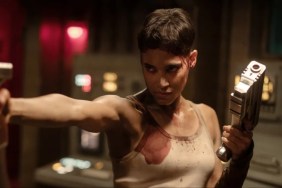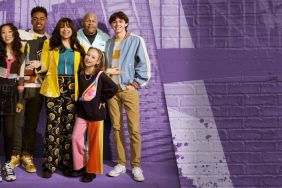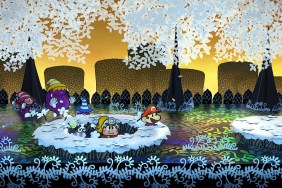The director is always the busiest guy on any movie set, because they’re always either in the middle of filming a scene or prepping the next one, and are constantly being approached by the cast and all of the tech departments to figure out exactly what is necessary to achieve their vision.
This time around, we got to talk to Zack Snyder (who also co-wrote and is producing the film) on set as we waited between set-ups of the girls jumping out of the helicopter onto the bullet train, and there was a lot of stuff going on around us–construction, moving rigs, etc.–but Zack still was able to give us as much of his time as possible to talk about his reasons for wanting to make Sucker Punch.
ComingSoon.net: I’m going to ask the question you’re going to get every time you do an interview – why did you call this “Sucker Punch”?
Zack Snyder: It’s called “Sucker Punch” because I think in a way the movie is not just about like… the story has some pop culture implications so I didn’t want to like try and (go with) “Untitled Zack Snyder Project” so “Sucker Punch” kind of summed up how I felt about it when I was working on it. I dunno.
CS: Does the title still work for you?
Snyder: Yeah, it still does, especially as I see the movie kind of unfolding, definitely.
CS: When they were showing us some of the FX sequences they were talking about how “Excalibur” was an influence or “Lord of the Rings.” How much of this for you is inspired specifically by pop cultural things and how much of it is you trying to do something that is not homage?
Snyder: It’s weird because when you distill something down, so let’s say it goes beyond, “Oh, I like these movies,” (Laughs) and it becomes just how pop culture has sort of digested these images and things like that and so I’m sort of using myself as the filter of some kind, then when we went to write it we never even went like, “Oh, should we do like ‘Lord of the Rings’ here and ‘Excalibur’ there?” It was more just those influences were in us and we went, “Oh, that would be cool.”
CS: We’ve heard you’ve been thinking about this for a long time. When did the idea come up and how did it develop?
Snyder: I had been working on this other story a long time ago and there was a character in it, this Babydoll character, and she kind of went on these sort of fantasies. She was only like a small side of the story, but it’s like those characters that you’re like, “Oh, that’s cool.” Then we just kept talking about her and sort of seeing how it evolved and then this story kind of happened. It happened over quite a little period of time, but the actual structure of what it is, is locked in. We had been talking about it, knowing what it was, for quite a while and I’ve just been busy with all these other things and never really got around to it.
CS: How important was it for you to finally do something that’s completely originated by you and that it’s your project?
Snyder: I think that it’s a big deal. I’ve gotten a little bit exhausted by… I love adapting things and I love making those pictures real, but I felt like I was ready to just not have anyone to sort of, as far as whether the canon was correctly represented other than myself.
CS: Has it been liberating?
Snyder: It has, it has. It allows us every day to just go, “You know, this would be even better.” So the thing evolves and it’s a movie so it evolves in that way. But my influences I think they are pretty glaringly obvious, but on the other hand, I take them very seriously, the struggles I go through I take very seriously, so for me, all the sort of iconology that the movie embodied, and then the struggle that girls go through, even though it’s built on pop culture sort of imagery, I take it really seriously as far as what they’re sort of emotional struggles are and what they really go through.
CS: How pleasant is it not having forty sweaty guys around you while you’re doing these stunts?
Snyder: It’s kinda nice, a kinda nice movie. The girls have trained so hard and they’ve done such a great job. It’s good fun too. They’re all crazy individuals, every single one of them. They took this character that I wrote and they turned it into a real thing and they really took it all the way. The movie’s pretty hardcore. Let me just take a quick look there.
(At this point, Zack steps away to watch a rehearsal.)
CS: It seems like the biggest trick in a film like this, forget all the ambition, forget the fact that you have nine or ten different levels of reality in this, but it seems like tone would be the hardest thing.
Snyder: It is and you know how I feel about that. I feel like the tone, I’m really happy so far with kinda where we…
CS: Is there a consistent throughline through it?
Snyder: Yeah, it’s really interesting. I think that to me the tone, it has to do with. I mean it kind of has a slightly dark, from the point of view whether it’s in the insane asylum or the brothel or these adventures, everything is dangerous and everyone is emotionally trying to find their way and I think those adventures are all metaphors for sort of what’s happening emotionally when the event is happening. We’re always at a point in the film where these transitions are happening to these characters emotionally and then during the event you kind of get some of that.
CS: It looks like a Terry Gilliam film on steroids. Gilliam’s famous for always directly tying the character to theme and they’re never just a fantasy for the sake of it.
Snyder: Yeah, and I think that that is kind of what it’s about for me. I think that the other fun thing about the way that the girls work out there, and also not just individuals, but it’s weird because the group dynamic is also sort of affected by what happens even though the way the move is kind of constructed so that if they steal the mask, it’s not a super-complicated affair in their world, but in fantasy world, it is super-complicated and dangerous and it’s life or death and they’re fighting these exotic World War I steampunk (soldiers), but that struggle is directly related to again, they’re just trying to figure out whether this will work and they kinda don’t trust each other and don’t really work that well together yet. All of those things kind of manifesting, but that in the end they’re able to persevere and to pull it off. Then that brings them closer together for the next one and the next one. This one of course, the bullet train is the most… it all goes a little awry on this one.
CS: How difficult was it to maintain or preserve that kind of conceptual or emotional undercurrent for these set pieces? Did you think of like what the sort of metaphor was and then create the set piece?
Snyder: Yeah, that’s kinda how we did it. We were like, “Okay, I want to steal a map and I want to steal fire, I want to steal a super dangerous device. In their world it’s a knife, but here it’s a crazy bomb.” So that’s kinda how those things started, and then we would say, “Okay, well, the map is kind of a labyrinthine sort of it object. It represents sort of” so we thought everybody was going to be a fan of trench warfare and that kind of imagery. I was like, “Oh, it would be cool to do it in World War I, because trenches are cool and crazy.”
CS: Is that what excited you about the project, the fact that you really get to make several different movies?
Snyder: Yeah, I mean also I gotta say… there’s that part of it of course which is super exciting, but also what the girls bring and the drama of Baby’s story really in the end is what became the thing that made me okay, “Okay, I gotta make it ’cause it’s cool. I want to see it. I want to see this worked out.” That kinda became the thing, then of course, the studio they were a little bit like, “What is this? It’s not based on anything and it’s super strange…”
CS: Were they concerned coming off of “Watchmen”?
Snyder: Nah, I think their biggest thing was about whether they felt like it was too obscure, too strange. And I go, “No, I get that. I understand why.” I cut together a little trailer to show them what it could be like and everyone’s like, “Oh, there’s an adventure in it.” I’m like, “Yeah, there’s a lot of adventure in it,” so then it kind of changed a little bit. I think that like anything it’s based on–especially when it’s an idea that no one’s ever seen–it’s a big deal to get other people to go, “Yeah, sure, okay. So five girls go on crazy adventures, and they’re really in a brothel, but they’re really in an insane asylum. Okay, that sounds great.” It is a bit of a struggle, but on the other hand, it is original and it is actiony and the girls are amazing and the setting is sexy, and on the other hand it’s kinda easy. (Laughs)
CS: Is there anything you wanted to do, that you either weren’t able to or that you had to pull back in on terms of violence or sex and that kind of stuff?
Snyder: Oh, everything, both. (Laughs) I just think my default setting is pretty rough, thank God, so it’s been an interesting exercise for me to kind of work in this idea that the movie was gonna be PG-13 and not this crazy hard R that…
CS: What you’re used to?
Snyder: Yeah, and in some ways I think it’s been better.
CS: Wait, this is a PG-13 movie?
Snyder: Yeah, that’s where we’re (going).
CS: Wow, so is there an R-rated cut you’re shooting as well?
Snyder: I don’t know if they already cut it, it could be… But no, I mean, because we’ve really endeavored to–for instance, in this world they fight robots–so we really tried to find enemies, sort of soulless enemies for them to fight, but it’s pretty intense.
CS: I want to ask about the references. The reference to “Excalibur,” people won’t be too surprised or the Manga probably won’t be too big a surprise, but the “Moulin Rouge!” thing, you actually have Marius DeVries doing some music and that might throw some people off. Was that something very early on that you decided you wanted to have musical numbers?
Snyder: Yeah, I felt like the movie has sort of a musical ending and it always struck me as an important thing to do the music right. I love musical movies as entertainment, the way the music and imagery kinda come together. It’s been a thing that I’ve always been a fan of and I think it’s pretty amazing. Marius has done an amazing job so far just giving us the tracks, the little skeletons of tracks that we’ve worked with for the action sequences and some of the other sequences. So yeah, I like Baz and I don’t know, it’s a great movie.
CS: As a male writer/director making a movie about the imagination of four women, how careful did you have to be about the line between empowerment and exploitation?
Snyder: I don’t think there was a version that the girls would’ve let me do that they didn’t feel was… it’s all about power, the movie, so anytime you are dealing with power and men and women, you are on the edge with everybody, so this movie is all about being on the edge in that way, like, when is a person strong and when is a person weak. That’s what it’s all about, you know, and when to take advantage of that and when people take advantage of it and when do you have to dig deep down inside yourself.










